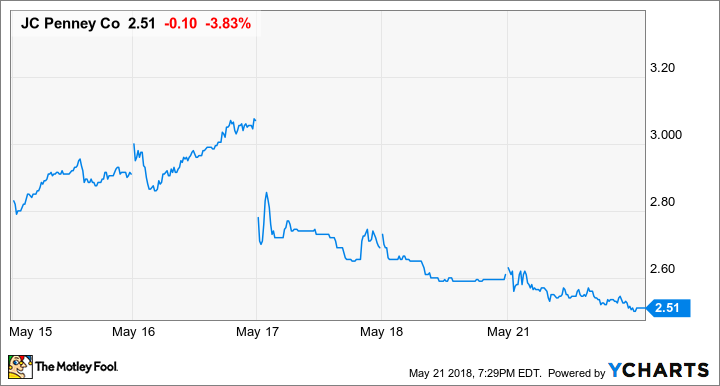Last Thursday, J.C. Penney (JCPN.Q) reported disappointing results for the first quarter of fiscal 2018. Comparable-store sales inched up just 0.2%: near the bottom of the company's full-year guidance range and worse than what management had expected. Furthermore, gross margin plunged by 2.4 percentage points, putting pressure on profitability. J.C. Penney also lowered its full-year earnings per share guidance range by $0.12 because of changes in accounting rules.
Not surprisingly, investors punished J.C. Penney for its subpar first-quarter performance. J.C. Penney stock fell nearly 20% over the course of the three trading days following its earnings report.
J.C. Penney Stock Performance, data by YCharts.
However, I still expect J.C. Penney's performance to improve going forward. As a result, I plan to hold on to all of my J.C. Penney stock. And if the stock continues to slide, I would even consider buying more shares of the company.
Weather undermined first-quarter sales
Unseasonably cold weather had a significant negative impact on J.C. Penney's sales performance last quarter, particularly in the first half of April. In fact, comp sales plunged by double-digits in each of the first two weeks of the April retail month. Management estimates that J.C. Penney would have posted a 1.5% comp sales gain last quarter if weather patterns had been more normal.
To many investors, blaming weak sales on the weather seems like a lame excuse, particularly when CEO Marvin Ellison has been touting efforts to reduce the business's weather sensitivity. That's a big reason J.C. Penney stock has plunged in the past week.
That said, J.C. Penney wasn't the only retailer to point to unfavorable weather as a sales drag during the first quarter. Furthermore, J.C. Penney's management noted that sales trends were the worst in the Northeast and Midwest regions, which correlates well with weather patterns.

J.C. Penney reported poor sales trends in the Midwest and Northeast last quarter. Image source: J.C. Penney.
The unfavorable weather trends also contributed to J.C. Penney's gross margin weakness. First, apparel is one of the company's highest-margin product categories, so weak sales in that category hurt gross margin. Second, when a retailer misses its sales plan, it has to mark down unwanted seasonal merchandise to make room for the next season's products.
New categories also have seasonality
In the past two years or so, J.C. Penney has expanded its merchandise assortment in order to reduce its weather sensitivity. The company's return to the appliance business has drawn the most attention. This move to capture market share from Sears Holdings (SHLDQ) has been very effective so far. That said, J.C. Penney has also put toy shops in all of its stores and expanded its furniture and mattress offerings.
However, while these product categories may not be weather-sensitive, they are seasonal. For example, sales of big-ticket items like appliances, mattresses, and furniture tend to peak around federal holidays. While President's Day weekend falls in the first quarter, many consumers are still recovering from their holiday shopping then.
By contrast, Memorial Day, the Fourth of July, Labor Day, Columbus Day, and Black Friday fall during the other three quarters of the year. They all correspond to major sales events for big-ticket items. Indeed, Marvin Ellison noted last year that the sales benefit from appliances alone is nearly twice as big in the second quarter as it is during the first quarter.
Meanwhile, toy sales are heavily weighted toward the fourth quarter, especially the month between Thanksgiving and Christmas. Thus, the merchandise categories J.C. Penney is leaning on for growth are likely to perform better during the remainder of the fiscal year.
The benefit of competitors' store closures is coming
Another reason I expect J.C. Penney stock to bounce back is that the company will start to benefit from competitors' store closures soon. Bon-Ton and Toys R Us are both in the midst of liquidation sales and will be gone by the end of the second quarter. That will open up sales opportunities in apparel and toys (among other product categories) in the back half of the year.
Furthermore, Sears Holdings' store closures are continuing at a furious pace. The company announced the closure of 39 Sears stores and 64 Kmart stores back in January. In the past month or so, it has decided to close dozens of additional stores, including at least 32 Sears locations.
In total, between April and August, Sears will have closed at least 30 full-line stores that are in the same mall or the immediate vicinity of a J.C. Penney store that sells appliances. That's roughly equal to the total for all of fiscal 2017. Furthermore, J.C. Penney is testing options for a smaller appliance section that could be installed in some of the company's smaller locations. This would expand J.C. Penney's opportunity to take market share from Sears Holdings.
J.C. Penney stock is certainly a risky investment. The company has a weak balance sheet, EPS is near zero, and free cash flow production has been erratic. However, J.C. Penney will benefit from better seasonality for its new merchandise categories during the rest of fiscal 2018, while the tailwind from competitors' store closures will really ramp up in the second half of the year. Thus, a more sustainable sales and earnings recovery could begin within the next few quarters.






